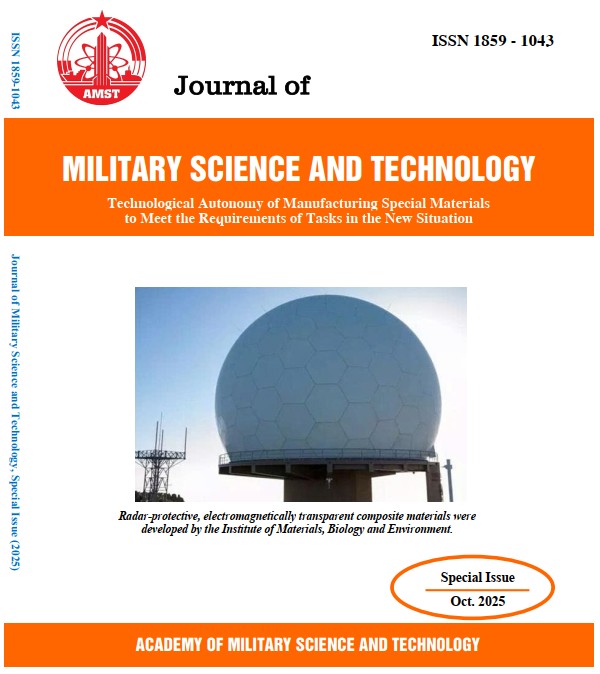Study on the effect of halloysite nanotubes on the adhesion and corrosion protection of epoxy coatings on carbon steel
DOI:
https://doi.org/10.54939/1859-1043.j.mst.IMBE.2025.179-185Keywords:
Corrosion; Epoxy coating; Halloysite; Adhesion; Dispersion.Abstract
Halloysite nanotubes (HNT) are naturally occurring clay minerals with abundant reserves, commonly employed as carriers for corrosion inhibitors in protective coatings. However, the direct influence of HNT on the physico-mechanical properties and corrosion resistance of coatings has received limited attention. In this study, a procedure for dispersing HNT into an epoxy binder was established, and the effect of HNT loading on adhesion strength and corrosion protection was subsequently evaluated, using pull-off adhesion tests and electrochemical measurements. The results demonstrated that HNT was uniformly dispersed in the epoxy via a sequential process consisting of ultrasonic agitation in a solvent, mechanical stirring, and subsequent ultrasonication in the epoxy mixture. Experimental results indicated that epoxy coatings incorporating HNT exhibited 1.84–2.64 times higher adhesion strength than neat epoxy coatings, with adhesion increasing progressively as HNT content rose from 1 to 3 wt.% and showing negligible variation upon further increase to 5 wt.%. Moreover, the corrosion rate of carbon steel was markedly reduced in the presence of HNT, reaching a minimum value of 0.0328×10-3 mm/y at 3 wt.% HNT loading. It was shown that a relatively low HNT loading was sufficient to enhance adhesion strength and corrosion resistance of epoxy coatings, highlighting the potential of this nanomaterial for protective coatings.
References
[1]. B. E. Ibrahimi, J. V. Nardeli, and L. Guo, “Sustainable corrosion inhibitors I: Fundamentals, methodologies, and industrial applications,” American Chemical Society, pp. 1-19, (2021).
[2]. I. Chopra et al., “Recent advances in epoxy coatings for corrosion protection of steel: Experimental and modelling approach—A review,” Materials Today: Proceedings, Vol. 62, (2022).
[3]. G. Cui et al., “A comprehensive review on smart anti-corrosive coatings,” Progress in Organic Coatings, Vol. 148, pp. 105821, (2020).
[4]. A. C. Santos et al., “Halloysite clay nanotubes for life sciences applications: From drug encapsulation to bioscaffold,” Advances in Colloid and Interface Science, Vol. 257, pp. 58-70, (2018)
[5]. A. I. Idumah et al., “Recently emerging advancements in halloysite nanotubes polymer nanocomposites,” Composite Interfaces, Vol. 26, No. 9, pp. 751-824, (2019).
[6]. H. Vahabi et al., “Flame retardant epoxy/halloysite nanotubes nanocomposite coatings: Exploring low-concentration threshold for flammability compared to expandable graphite as superior fire retardant,” Progress in Organic Coatings, Vol. 119, pp. 8-14, (2018).
[7]. G. Ravichandran et al., “Enhancement of mechanical properties of epoxy/halloysite nanotube (HNT) nanocomposites,” SN Applied Sciences, Vol. 1, No. 4, p. 296, (2019).
[8]. Y. Liu et al., “A novel dual-responsive halloysite nano-container for anti-corrosion coatings,” Anti-Corrosion Methods and Materials, Vol. 69, (2022).
[9]. K. Zahidah et al., “Benzimidazole-loaded halloysite nanotube as a smart coating application,” International Journal of Engineering and Technology Innovation, Vol. 7, pp. 243-254, (2017).
[10]. L. Lisuzzo et al., “Colloidal stability of halloysite clay nanotubes,” Ceramics International, Vol. 45, No. 2, pp. 2858-2865, (2019).
[11]. S. Srivastava, A. Pandey, and M. Agarwal, “Metallurgical evaluation of halloysite-epoxy composite processed by ultrasonication,” Materials Today: Proceedings, Vol. 49, pp. 239-242, (2022).
[12]. T. Ngo et al., “Effect of temperature, duration and speed of pre-mixing on the dispersion of clay/epoxy nanocomposites,” Composites Science and Technology, Vol. 69, pp. 1831-1840, (2009).
[13]. N. T. Anh, et al., “Influence of hydrotalcite containing corrosion inhibitor modified by silane on corrosion protection performance of epoxy coating,” VNU Journal of Science: Natural Sciences and Technology, Vol. 33, No. 4, (2017).
[14]. T. Anh Truc et al., “Improvement of adherence and corrosion protection properties of an epoxy-polyamide coating on steel by incorporation of an indole-3 butyric acid-modified nanomagnetite,” Journal of Coatings Technology and Research, Vol. 13, pp. 489-499, (2016).
[15]. P. Chen et al., “Adhesion and erosion properties of epoxy resin composite coatings reinforced with fly ash cenospheres and short glass fibers,” Progress in Organic Coatings, Vol. 125, pp. 489-499, (2018).
[16]. A. M. El Saeed, M. A. E. Fattah, and M. M. Dardir, “Synthesis and characterization of titanium oxide nanotubes and its performance in epoxy nanocomposite coating,” Progress in Organic Coatings, Vol. 78, pp. 83-89, (2015).
[17]. L. L. Zhai, G. Ling, and Y. Wang, “Effect of nano-Al2O3 on adhesion strength of epoxy adhesive and steel,” International Journal of Adhesion and Adhesives, Vol. 28, pp. 23-28, (2008).
[18]. J. P. B. van Dam et al., “Effect of surface roughness and chemistry on the adhesion and durability of a steel-epoxy adhesive interface,” International Journal of Adhesion and Adhesives, Vol. 96, pp. 102450, (2020).
[19]. J. H. Kim et al., “Improvement adhesion durability of epoxy adhesive for steel/carbon fiber-reinforced polymer adhesive joint using imidazole-treated halloysite nanotube,” Advanced Composites and Hybrid Materials, Vol. 8, No. 1, pp. 135, (2025).
[20]. S. W. Yap et al., “Superhydrophobic zinc oxide/epoxy coating prepared by a one-step approach for corrosion protection of carbon steel,” Journal of Materials Research and Technology, Vol. 25, pp. 5751-5766, (2023).
[21]. R. Hsissou et al., “New epoxy composite polymers as a potential anticorrosive coatings for carbon steel in 3.5% NaCl solution: Experimental and computational approaches,” Chemical Data Collections, Vol. 31, p. 100619, (2021).
[22]. X. Lu et al., “Corrosion protection of hydrophobic bisphenol A-based polybenzoxazine coatings on mild steel,” RSC Advances, Vol. 6, pp. 5805-5811, (2016).
[23]. D.V. Amaral Ceretti et al., “The role of dispersion technique and type of clay on the mechanical properties of clay/epoxy composites,” Macromol. Symp., Vol. 383, No. 1, p. 1800055, (2019).
[24]. P. Vijayan, Y. M. Hany El-Gawady, and M. A. S. A. Al-Maadeed, “Halloysite nanotube as multifunctional component in epoxy protective coating,” Industrial & Engineering Chemistry Research, Vol. 55, No. 42, pp. 11186-11192, (2016).
[25]. S. G. Croll, “Surface roughness profile and its effect on coating adhesion and corrosion protection: A review,” Progress in Organic Coatings, Vol. 148, pp. 105847, (2020).
[26]. M. Shukla and K. Sharma, “Effect of carbon nanofillers on the mechanical and interfacial properties of epoxy-based nanocomposites: A review,” Polymer Science Series A, Vol. 61, pp. 439-460, (2019).







